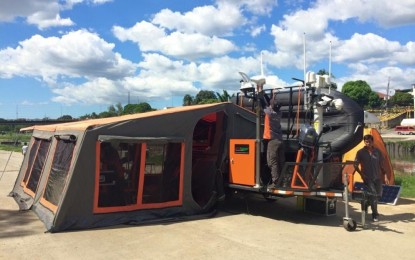
A Mobile and Command Post and Triaging Trailer Tent can be put up in a short period of time, and can be placed anywhere when a disaster strikes, according to the DOST. (Photo courtesy of Dennis Abella)
MANILA -- The chief of the Philippine Institute of Volcanology and Seismology (Phivolcs) is urging researchers and inventors to seek the Department of Science and Technology's (DOST) assistance if they have works related to disaster mitigation.
"We encourage researchers and inventors to get in touch with the DOST if they have innovations related to disaster mitigation, preparedness and response. Aside from regional offices, we have the Technology Application and Promotion Institute, which is the (DOST-attached) agency that assists inventors to commercialize their products," Phivolcs director Renato Solidum, Jr. told the Philippine News Agency in an interview Monday.
He said the DOST has three councils -- the Philippine Council for Industry, Energy and Emerging Technology Research and Development (PCIEERD), Philippine Council for Health Research and Development (PCHRD), and the Philippine Council for Agriculture, Aquatic and Natural Resources Research and Development (PCAARRD) -- which could help them improve their products through technical assistance as well as research funding.
He cited as example the Mobile and Command Post and Triaging Trailer Tent developed by Dennis Abella, that was assisted by the DOST through promotions.
"This was not funded by the DOST as this was Abella's own initiative. There is an agreement between DOST regional offices and the Filipino Inventors Society Producers Cooperative to support each other’s programs and projects," Solidum clarified, adding that it is the local government units (LGUs) which shoulder the expenses every time a mobile and command post would be put up.
Abella told the PNA that it would only take 15 minutes to put up the command post, and the target users are the LGUs.
It was first deployed in Bacoor City in 2015, he added.
"This was conceptualized in 2013, after the Typhoon Yolanda (Haiyan). At that time, the impact of the typhoon was devastating, even the DRRMO (Disaster Risk Reduction Management Office) was wiped out. That was when we realized we needed an equipment that could sustain typhoons and can be deployed post-disaster for communications, rescue and medical training," Abella said.
He said it is currently being used by the LGUs in Makati, Pasay, Bacoor, Muntinlupa, Quezon City, and Capiz.
Other notable deployments, he said, were during typhoons to monitor and the conduct of rescue, during the Papal visit for surveillance and medical triaging, and during a fire in Bacoor for coordination among different departments.
The mobile command post was also used during the pandemic lockdown and deployed in checkpoints for surveillance, he continued.
"(The) DSWD (Department of Social Welfare and Development) also used it during Taal Volcano eruption, for the purpose of medical triaging and communication," he said.
Meanwhile, Solidum noted the Phivolcs' commitment to support the local inventors in terms of disaster mitigation efforts.
"The DOST is committed to continue its science, technology and innovation initiatives and support Filipino inventors and researchers to increase resilience of our communities, LGUs, businesses and organizations, so that we achieve a safer Philippines," Solidum said. (PNA)
